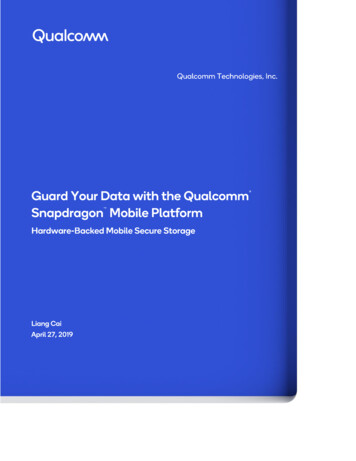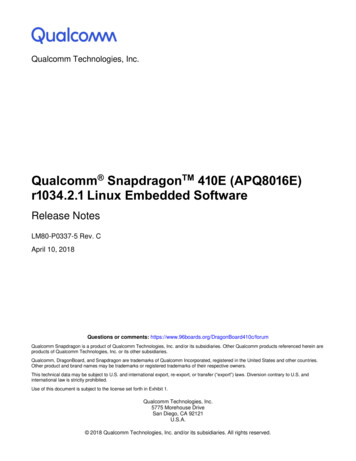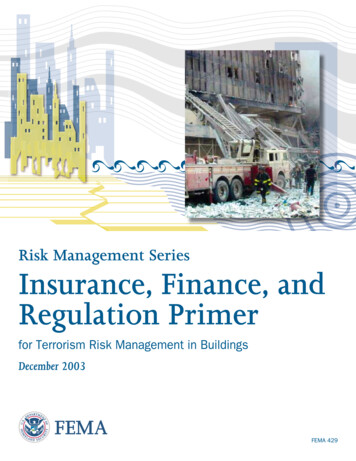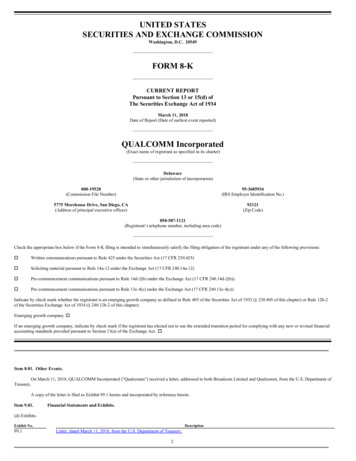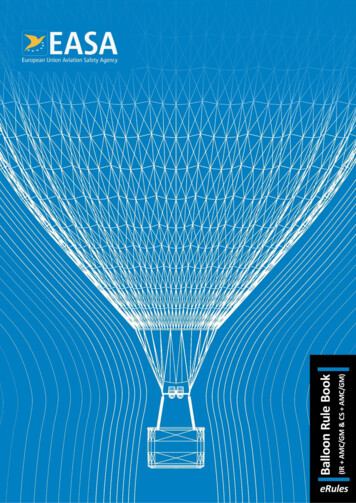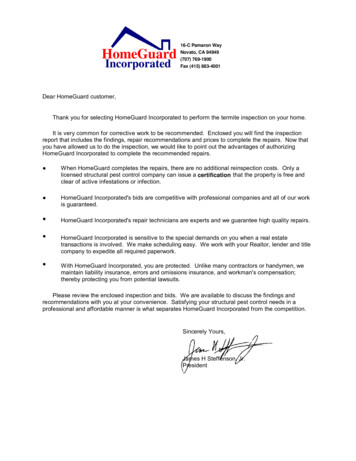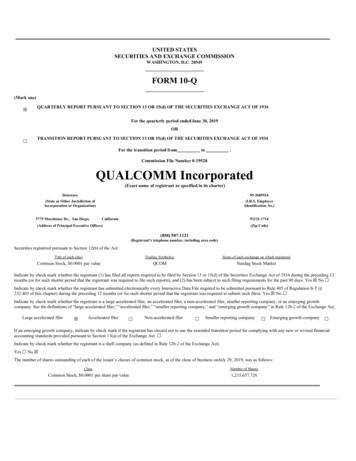
Transcription
UNITED STATESSECURITIES AND EXCHANGE COMMISSIONWASHINGTON, D.C. 20549FORM 10-Q(Mark one) QUARTERLY REPORT PURSUANT TO SECTION 13 OR 15(d) OF THE SECURITIES EXCHANGE ACT OF 1934For the quarterly period ended June 30, 2019OR TRANSITION REPORT PURSUANT TO SECTION 13 OR 15(d) OF THE SECURITIES EXCHANGE ACT OF 1934For the transition period fromto.Commission File Number 0-19528QUALCOMM Incorporated(Exact name of registrant as specified in its charter)Delaware95-3685934(State or Other Jurisdiction ofIncorporation or Organization)(I.R.S. EmployerIdentification No.)5775 Morehouse Dr., San Diego,California92121-1714(Address of Principal Executive Offices)(Zip Code)(858) 587-1121(Registrant’s telephone number, including area code)Securities registered pursuant to Section 12(b) of the Act:Title of each classTrading Symbol(s)Name of each exchange on which registeredCommon Stock, 0.0001 par valueQCOMNasdaq Stock MarketIndicate by check mark whether the registrant (1) has filed all reports required to be filed by Section 13 or 15(d) of the Securities Exchange Act of 1934 during the preceding 12months (or for such shorter period that the registrant was required to file such reports), and (2) has been subject to such filing requirements for the past 90 days. Yes No Indicate by check mark whether the registrant has submitted electronically every Interactive Data File required to be submitted pursuant to Rule 405 of Regulation S-T (§232.405 of this chapter) during the preceding 12 months (or for such shorter period that the registrant was required to submit such files). Yes No Indicate by check mark whether the registrant is a large accelerated filer, an accelerated filer, a non-accelerated filer, smaller reporting company, or an emerging growthcompany. See the definitions of “large accelerated filer,” “accelerated filer,” “smaller reporting company,” and “emerging growth company” in Rule 12b-2 of the Exchange Act.Large accelerated filer Accelerated filer Non-accelerated filer Smaller reporting company Emerging growth company If an emerging growth company, indicate by check mark if the registrant has elected not to use the extended transition period for complying with any new or revised financialaccounting standards provided pursuant to Section 13(a) of the Exchange Act. Indicate by check mark whether the registrant is a shell company (as defined in Rule 12b-2 of the Exchange Act).Yes No The number of shares outstanding of each of the issuer’s classes of common stock, as of the close of business onJuly 29, 2019, was as follows:ClassNumber of SharesCommon Stock, 0.0001 per share par value1,215,657,726
QUALCOMM IncorporatedForm 10-QFor the Quarter Ended June 30, 2019PagePART I. FINANCIAL INFORMATIONItem 1.Condensed Consolidated Financial Statements (Unaudited)Condensed Consolidated Balance SheetsCondensed Consolidated Statements of OperationsCondensed Consolidated Statements of Comprehensive Income (Loss)Condensed Consolidated Statements of Cash FlowsCondensed Consolidated Statements of Stockholders’ EquityNotes to Condensed Consolidated Financial StatementsItem 2.Management’s Discussion and Analysis of Financial Condition and Results of OperationsItem 3.Quantitative and Qualitative Disclosures About Market RiskItem 4.Controls and Procedures345678306262PART II. OTHER INFORMATIONItem 1.Legal ProceedingsItem 1A.Risk FactorsItem 2.Unregistered Sales of Equity Securities and Use of ProceedsItem 3.Defaults Upon Senior SecuritiesItem 4.Mine Safety DisclosuresItem 5.Other InformationItem 6.Exhibits62626363636364SIGNATURES662
PART I. FINANCIAL INFORMATIONITEM 1. CONDENSED CONSOLIDATED FINANCIAL STATEMENTS (UNAUDITED)QUALCOMM IncorporatedCONDENSED CONSOLIDATED BALANCE SHEETS(In millions, except per share data)(Unaudited)June 30,2019September 30,2018ASSETSCurrent assets:Cash and cash equivalents Marketable securities13,923 11,777435311Accounts receivable, net2,3902,904Inventories1,7741,693Other current assetsTotal current assets68269919,20417,384Deferred tax assets1,172936Property, plant and equipment, net3,0372,975Goodwill6,3086,498Other intangible assets, net2,3502,955Other assets2,062Total assets1,970 34,133 1,587 32,718LIABILITIES AND STOCKHOLDERS’ EQUITYCurrent liabilities:Trade accounts payablePayroll and other benefits related liabilities1,014Unearned revenuesShort-term debtOther current 85311,3891,2512,1141,6202,312Long-term debt13,42615,365Other liabilities1,0261,22528,67031,911——Total current liabilitiesUnearned revenuesIncome taxes payableTotal liabilitiesCommitments and contingencies (Note 6)Stockholders’ equity:Preferred stock, 0.0001 par value; 8 shares authorized; none outstandingCommon stock and paid-in capital, 0.0001 par value; 6,000 shares authorized; 1,218 and 1,219 shares issued and outstanding,respectivelyRetained earningsAccumulated other comprehensive incomeTotal stockholders’ equity581—4,6875421952655,463 Total liabilities and stockholders’ equitySee accompanying notes.334,133807 32,718
QUALCOMM IncorporatedCONDENSED CONSOLIDATED STATEMENTS OF OPERATIONS(In millions, except per share data)(Unaudited)Three Months EndedJune 30,2019Nine Months EndedJune 24,2018June 30,2019June 24,2018Revenues:Equipment and services Licensing3,531 4,110 11,037 st of revenues2,1142,4916,4817,394Research and development1,3801,4163,9574,237Selling, general and otal costs and expenses4,3184,67412,49215,533Operating income5,3179036,9671,300Total revenuesCosts and expenses:Interest expense(160)(212)(477)Investment and other income, net344243377454Income before income taxes5,5019346,8671,193Income tax (expense) benefit(3,352)268(561)(2,987)(5,644) 2,149 1,202 3,880 (4,451)Basic earnings (loss) per share 1.77 0.81 3.20 (3.01)Diluted earnings (loss) per share 1.75 0.81 3.17 (3.01)Net income (loss)Shares used in per share 1,4871,2241,479See accompanying notes.4
QUALCOMM IncorporatedCONDENSED CONSOLIDATED STATEMENTS OF COMPREHENSIVE INCOME (LOSS)(In millions)(Unaudited)Three Months EndedJune 30,2019Net income (loss) Nine Months EndedJune 24,20182,149 June 30,20191,202 June 24,20183,880 (4,451)Other comprehensive income (loss), net of income taxes:Foreign currency translation gains (losses)14(237)(27)(64)Reclassification of foreign currency translation losses included in net income (loss)Reclassification of net other-than-temporary losses on available-for-sale securitiesincluded in net income (loss)——1————1Net unrealized gains (losses) on other available-for-sale securities—3(6)2Reclassification of net realized losses (gains) on available-for-sale securities included innet income 19)(61)Net unrealized gains (losses) on derivative instrumentsReclassification of net realized (gains) losses on derivative instruments included in netincome (loss)Other gains (losses)Total other comprehensive income (loss)Comprehensive income (loss) See accompanying notes.52,171 980 3,861 (4,512)
QUALCOMM IncorporatedCONDENSED CONSOLIDATED STATEMENTS OF CASH FLOWS(In millions)(Unaudited)Nine Months EndedJune 30,2019June 24,2018Operating Activities:Net income (loss) 3,880 (4,451)Adjustments to reconcile net income (loss) to net cash provided by operating activities:Depreciation and amortization expense1,0511,165Income tax provision in excess of income tax payments2,2064,958Non-cash portion of share-based compensation expense698659Net gains on marketable securities and other investments(340)(101)Indefinite and long-lived asset impairment charges20396Impairment losses on marketable securities and other investments11140(207)(46)Other items, netChanges in assets and liabilities:Accounts receivable, net1,451470Inventories(95)Other assets1572(267)(296)Trade accounts payablePayroll, benefits and other liabilities245(2,534)Unearned revenues1,698(113)Net cash provided by operating activities(178)6,0594,331Investing Activities:Capital expenditures(570)Purchases of debt and equity marketable securitiesProceeds from sales and maturities of debt and equity marketable securitiesAcquisitions and other investments, net of cash acquiredProceeds from other investmentsOther items, net(625)—(5,835)1249,105(185)(192)45207117Net cash (used) provided by investing activities(45)(469)2,615Financing Activities:Proceeds from short-term debt4,8089,385Repayment of short-term debt(4,813)(7,198)Repayment of long-term debt—Proceeds from issuance of common stock(1,571)264387Repurchases and retirements of common stock(1,088)(1,425)Dividends paid(2,257)(2,600)(225)(273)Payment of purchase consideration related to RF360 joint venture(44)(157)Other items, net(91)(54)(3,446)(3,506)Payments of tax withholdings related to vesting of share-based awardsNet cash used by financing activitiesEffect of exchange rate changes on cash and cash equivalents2Net increase in total cash and cash equivalents(19)2,146Total cash and cash equivalents at beginning of period3,42111,777Total cash and cash equivalents at end of period37,029 13,923 40,450 13,923 35,619 40,450Reconciliation to the condensed consolidated balance sheetsCash and cash equivalentsRestricted cash and restricted cash equivalents included in other assets— Total cash and cash equivalents at end of periodSee accompanying notes.613,9234,831
QUALCOMM IncorporatedCONDENSED CONSOLIDATED STATEMENTS OF STOCKHOLDERS’ EQUITY(In millions, except per share data)(Unaudited)Three Months EndedJune 30,2019 Total stockholders’ equity, beginning balanceNine Months EndedJune 24,20183,866 June 30,201923,735 June 24,2018807 30,725Common stock and paid-in capital:Balance at beginning of period384495—8550262Repurchases and retirements of common stock(69)(668)(205)Share-based compensation263200749699Tax withholdings related to vesting of share-based 4230,067——3,4552,1491,2023,880Common stock issued under employee benefit plans and the related tax benefitsBalance at end of period274393(1,093)Retained earnings:Balance at beginning of periodCumulative effect of accounting changes (Note 1)Net income (loss)Repurchases and retirements of common stockDividendsBalance at end of 1)—22(222)(19)(61)195323195323Accumulated other comprehensive income:Balance at beginning of periodCumulative effect of accounting changes (Note 1)Other comprehensive income (loss)Balance at end of periodTotal stockholders’ equity, ending balance 5,463 22,967 5,463 22,967Dividends per share announced 0.62 0.62 1.86 1.76See accompanying notes.7
QUALCOMM IncorporatedNOTES TO CONDENSED CONSOLIDATED FINANCIAL STATEMENTS(Unaudited)Note 1. Basis of Presentation and Significant Accounting Policies UpdateFinancial Statement Preparation. These condensed consolidated financial statements have been prepared in accordance with accounting principles generally accepted inthe United States of America (GAAP) for interim financial information and the instructions to Rule 10-01 of Regulation S-X. Accordingly, they do not include all of theinformation and notes required by GAAP for complete financial statements. In the opinion of management, the interim financial information includes all normal recurringadjustments necessary for a fair statement of the results for the interim periods. These condensed consolidated financial statements are unaudited and should be read inconjunction with our Annual Report on Form 10-K for the fiscal year ended September 30, 2018. Operating results for interim periods are not necessarily indicative of operatingresults for an entire fiscal year. We operate and report using a 52-53 week fiscal year ending on the last Sunday in September. Each of thethree-month and nine-month periodsended June 30, 2019 and June 24, 2018 included 13 weeks and 39 weeks, respectively.The preparation of financial statements in conformity with GAAP requires management to make estimates and assumptions that affect the reported amounts and thedisclosure of contingent amounts in our condensed consolidated financial statements and the accompanying notes. Actual results could differ from those estimates. Certain prioryear amounts have been reclassified to conform to the current year presentation.Revision of Prior Period Financial Statements. As previously disclosed, in connection with the preparation of our condensed consolidated financial statements for thethree months ended December 30, 2018, we identified an immaterial error related to the recognition of certain royalty revenues of our QTL (Qualcomm Technology Licensing)segment in the quarterly and annual periods in fiscal 2018 and third and fourth quarters and annual period in fiscal 2017. In accordance with SAB No. 99, “Materiality,” andSAB No. 108, “Considering the Effects of Prior Year Misstatements when Quantifying Misstatements in Current Year Financial Statements,” we evaluated the error anddetermined that the related impact was not material to our financial statements for any prior annual or interim period, but that correcting the cumulative impact of the errorwould be significant to our results of operations for the three months ended December 30, 2018. Accordingly, we have revised previously reported financial information forsuch immaterial error, as previously disclosed in our Quarterly Report on Form 10-Q for the first and second quarters of fiscal 2019. A summary of revisions to certainpreviously reported financial information presented herein for comparative purposes is included in Note 11. We will also correct previously reported financial information forsuch immaterial error in our future filings, as applicable.Earnings (Loss) Per Common Share. Basic earnings (loss) per common share is computed by dividing net income (loss) by the weighted-average number of commonshares outstanding during the reporting period. Diluted earnings per share is computed by dividing net income by the combination of dilutive common share equivalents,comprised of shares issuable under our share-based compensation plans and shares subject to accelerated share repurchase agreements, if any, and the weighted-average numberof common shares outstanding during the reporting period. Due to the net loss for the nine months ended June 24, 2018, all of the common share equivalents issuable undershare-based compensation plans had an anti-dilutive effect and were therefore excluded from the computation of diluted loss per share. The following table providesinformation about the diluted earnings (loss) per share calculation (in millions):Three Months EndedJune 30,2019Dilutive common share equivalents included in diluted sharesShares of common stock equivalents not included because the effect would be anti-dilutiveor certain performance conditions were not satisfied at the end of the period8Nine Months EndedJune 24,2018June 30,2019June 24,201813.99.09.3—0.70.69.943.2
QUALCOMM IncorporatedNOTES TO CONDENSED CONSOLIDATED FINANCIAL STATEMENTS(Unaudited)Share-Based Compensation. Total share-based compensation expense, related to all of our share-based awards, was comprised as follows (in millions):Three Months EndedJune 30,2019Cost of revenues 8Research and development 164Selling, general and administrativeShare-based compensation expense before income taxesRelated income tax benefit Nine Months EndedJune 24,2018June 30,20199 June 24,201823 )198 155 571 548At June 30, 2019, total unrecognized compensation expense related to nonvested restricted stock units granted prior to that date was 1.2 billion, which is expected to berecognized over a weighted-average period of 2.1 years. At June 30, 2019, we had outstanding 26.9 million restricted stock units and 1.1 million stock options that contain onlya service requirement.Recently Adopted Accounting Pronouncements.Revenue Recognition: In May 2014, the Financial Accounting Standards Board (FASB) issued new accounting guidance related to revenue recognition (ASC 606), whichoutlines a comprehensive revenue recognition model and supersedes most current revenue recognition accounting guidance and requires increased disclosures. The newaccounting guidance defines a five-step approach that requires a company to recognize revenue as control of goods or services transfers to a customer at an amount that reflectsthe expected consideration to be received in exchange for those goods or services. We adopted ASC 606 in the first quarter of fiscal 2019 using the modified retrospectivetransition method only to those contracts that were not completed as of October 1, 2018. We recognized the cumulative effect of initially applying the new revenue accountingguidance as an adjustment to opening retained earnings. Prior period results have not been restated and continue to be reported in accordance with the accounting guidance ineffect for those periods (ASC 605). We have implemented new accounting policies, systems, processes and internal controls necessary to support the requirements of ASC 606.Adoption of this new accounting guidance most significantly impacts the timing of sales-based royalty revenues, which are the vast majority of our QTL segment’srevenues. Prior to adoption, we recognized sales-based royalties as revenues in the period in which such royalties were reported by licensees, which was after the conclusion ofthe quarter in which the licensees’ sales occurred and when all other revenue recognition criteria had been met. Under the new accounting guidance, we estimate and recognizesales-based royalties in the period in which the associated sales occur, subject to certain constraints on our ability to estimate such amounts, resulting in an acceleration ofrevenue recognition compared to the historical method under ASC 605. Since we do not invoice for sales-based royalties estimated and recognized in any given quarter untilafter the conclusion of that quarter (which is generally the following quarter when such royalties are reported by licensees), revenues recognized from sales-based royaltiesresults in unbilled receivables (included in accounts receivable, net on the consolidated balance sheet). The adoption of ASC 606 did not otherwise have a material impact.The new accounting guidance also impacts the timing of recognizing certain customer incentives, which are recorded as a reduction to revenues in the period that therelated revenues are earned. Prior to adoption, we accounted for certain customer incentive arrangements, including volume-related and other pricing rebates or costreimbursements for marketing and other activities involving certain of our products and technologies, in part based on the maximum potential liability. Under the newaccounting guidance, we estimate the amount of all customer incentives.9
QUALCOMM IncorporatedNOTES TO CONDENSED CONSOLIDATED FINANCIAL STATEMENTS(Unaudited)The following table summarizes the cumulative effects of adopting the new revenue accounting guidance (substantially all of which related to the impact to QTL’s salesbased royalties) on our condensed consolidated balance sheet at October 1, 2018 (in millions):Balance as of September 30,2018Opening Balance as ofOctober 1,2018AdjustmentAssetsAccounts receivable, net 2,904 957Other current assets6991Deferred tax assets936(98 )Other assets1,970 3,86170083811,971LiabilitiesUnearned revenues, current 500 6 506Other current liabilities6,9781257,103Unearned revenues1,620(110 )1,510Stockholders’ equityRetained earnings 542 840 1,382The following tables summarize the impacts of adopting the new revenue accounting guidance on our condensed consolidated balance sheet and statements of operations(in millions):As of June 30, 2019As ReportedASC 606Balance SheetAdjustmentASC 605AssetsAccounts receivable, net 2,390Other current assets 682Deferred tax assets1,172Other assets2,062(1,070 ) (32 )1,3206501061,278(1 )2,061LiabilitiesUnearned revenues, current 527 (41 ) 486Other current liabilities4,725(31 )4,694Unearned revenues1,2511381,389Stockholders’ equityRetained earnings 4,68710 (1,063 ) 3,624
QUALCOMM IncorporatedNOTES TO CONDENSED CONSOLIDATED FINANCIAL STATEMENTS(Unaudited)Three Months Ended June 30, 2019As ReportedASC 606Statements of OperationsAdjustmentNine Months Ended June 30, 2019As ReportedASC 606ASC 605AdjustmentASC 605RevenuesEquipment and servicesLicensingInvestment and other income, netIncome tax (expense) benefitNet income 3,531 (10) 3,521 11,0376,104(239 )5,8658,422344(1 )343377 (80)(196 )— 9(201 )1,9483,880(223 )3,657Adoption of the new accounting guidance had no impact to net cash provided (used) by operating, financing or investing activities on our condensed consolidated statementof cash flows for the nine months ended June 30, 2019.Financial Assets: In January 2016, the FASB issued new accounting guidance on classifying and measuring financial instruments, which requires that all equityinvestments, other than equity-method investments, in unconsolidated entities generally be measured at fair value through earnings in the statement of operations. Additionally,it changes the disclosure requirements for financial instruments. We adopted the new accounting guidance in the first quarter of fiscal 2019 using the modified retrospectivetransition method for investments in marketable securities, which have readily determinable fair values, with the cumulative effect of applying the new accounting guidancerecognized as an adjustment to opening retained earnings. Upon adoption, we reclassified 50 million of unrealized gains, net of the associated tax effects, related to ourinvestments in marketable securities from accumulated other comprehensive income to opening retained earnings. We have applied the prospective transition method forinvestments in non-marketable securities, which are investments in privately held companies that do not have readily determinable fair values and will recognize, throughearnings, any unrealized gains that have accumulated in the period in which there is an observable transaction, if any.Hedge Instruments: In August 2017, the FASB issued new accounting guidance that expands and refines hedge accounting for both financial and non-financial risks, alignsthe recognition and presentation of the effects of hedging instruments and hedged items in the financial statements, and includes targeted improvements related to theassessment of hedge effectiveness. The new accounting guidance also modifies disclosure requirements for hedging activities. We adopted the new accounting guidance in thefirst quarter of 2019 using the modified retrospective transition method and recorded a negligible adjustment to opening retained earnings. The new accounting guidance did nothave a material impact on our condensed consolidated financial statements.Statement of Cash Flows: In August 2016, the FASB issued new accounting guidance related to the classification of certain cash receipts and cash payments in thestatement of cash flows. We adopted the new accounting guidance in the first quarter of fiscal 2019 using the retrospective transition method for each period presented, whichdid not have a material impact on our condensed consolidated statements of cash flows.In November 2016, the FASB issued new accounting guidance that requires companies to include restricted cash and cash equivalents as a component in total cash and cashequivalents on the statement of cash flows. As a result, the consolidated statement of cash flows no longer reflects transfers between cash and cash equivalents and restrictedcash and cash equivalents. We adopted the new accounting guidance in the first quarter of fiscal 2019 using the retrospective transition method, which results in certain amountsin fiscal 2018 being adjusted to conform to the new accounting guidance. This includes restricted cash and cash equivalents held during fiscal 2018 related to funds deposited ascollateral for outstanding letters of credit in connection with a then proposed acquisition. Restricted cash and cash equivalents related to the outstanding letters of credit totaled 2.0 billion at the end of the fourth quarter of fiscal 2017 and third quarter of fiscal 2018. Additionally, amounts for the nine months ended June 24, 2018 have been adjusted forrestricted cash and cash equivalents of 2.8 billion that was irrevocably deposited to redeem long-term debt in July 2018, resulting in a decrease in net cash used by financingactivities by such amount, with a corresponding increase in total cash and cash equivalents presented on the condensed consolidated statement of cash flows.Income Taxes: In October 2016, the FASB issued new accounting guidance that changes the accounting for the income tax effects of intra-entity transfers of assets otherthan inventory. Under the new accounting guidance, the selling (transferring) entity is required to recognize a current tax expense or benefit upon transfer of the asset. Similarly,the purchasing (receiving) entity is required to recognize a deferred tax asset or deferred tax liability, as well as the related11
QUALCOMM IncorporatedNOTES TO CONDENSED CONSOLIDATED FINANCIAL STATEMENTS(Unaudited)deferred tax benefit or expense, upon receipt of the asset. We adopted the new accounting guidance in the first quarter of fiscal 2019 using the modified retrospective transitionmethod, with the cumulative effect of applying the new accounting guidance recognized as an adjustment to opening retained earnings of 2.6 billion, primarily as the result ofestablishing a deferred tax asset on the basis difference of certain intellectual property distributed from one of our foreign subsidiaries to a subsidiary in the United States infiscal 2018. During the third quarter of fiscal 2019, the United States Treasury Department issued new temporary regulations that resulted in a change to the deductibility ofdividend income received by a U.S. stockholder from a foreign corporation. As a result of this change, pursuant to an agreement with the Internal Revenue Service, we willforgo the federal tax basis step-up in such distributed intellectual property. Therefore, the related deferred tax asset was written-off, resulting in a 2.5 billion charge to incometax expense in the third quarter of fiscal 2019 (Note 3). The ongoing impact of this accounting guidance will be dependent on the facts and circumstances of any transactionswithin its scope.Recent Accounting Pronouncements Not Yet Adopted.Leases: In February 2016, the FASB issued new accounting guidance related to leases that outlines a comprehensive lease accounting model and supersedes the currentlease accounting guidance. The new accounting guidance requires lessees to recognize right-of-use assets and corresponding lease liabilities on the balance sheet for leases witha lease term of greater than 12 months. It also changes the definition of a lease and expands the disclosure requirements of lease arrangements. We will adopt the newaccounting guidance in the first quarter of fiscal 2020 using the modified retrospective approach as of the effective date, and we will elect certain practical expedients. We do notexpect finance leases to be material at the time of adoption. We are in the process of determining the effects the adoption will have on our consolidated financial statements.Financial Assets: In June 2016, the FASB issued new accounting guidance that changes the accounting for recognizing impairments of financial assets. Under the newaccounting guidance, credit losses for financial assets held at amortized cost will be estimated based on expected losses rather than the current incurred loss impairment model.The new accounting guidance also modifies the impairment model for available-for-sale debt securities. The new accounting guidance generally requires the modifiedretrospective transition method, with the cumulative effect of applying the new accounting guidance recognized as an adjustment to opening retained earnings in the year ofadoption, except for certain financial assets where the prospective transition method is required, such as available-for-sale debt securities for which an other-than-temporaryimpairment has been recorded. We will adopt the new accounting guidance in the first quarter of fiscal 2021, and the impact of this new accounting guidance will largely dependon the composition and credit quality of our investment portfolio, as well as economic conditions at the time of adoption.Accounting Policy Update.Revenue Recognition: As a result of the adoption of ASC 606, we revised our revenue recognition policy beginning in fiscal 2019 as follows.We derive revenues principally from sales of integrated circuit products and licensing of our intellectual property. We also generate revenues by performing softwarehosting, software development and other services and from other product sales. The timing of revenue recognition and the amount of revenue actually recognized in each casedepends upon a variety of factors, including the specific terms of each arrangement and the nature of our performance obligations.Revenues from sales of our products are recognized upon transfer of control to the customer, which is generally at the time of shipment. Revenues from providing servicesare typically recognized over time as our performance obligation is satisfied. Revenues from providing services were less than 5% of total revenues for all periods presented.We grant licenses or otherwise provide rights to use portions of our intellectual property portfolio, which, among other rights, includes certain patent rights essential toand/or useful in the manufacture, sale or use of certain wireless products. Licensees pay royalties based on thei
Payroll and other benefits related liabilities 1,014 1,081 Unearned revenues 527 500 Short-term debt 3,000 1,005 Other current liabilities 4,725 6,978 Total current liabilities 10,853 11,389 Unearned revenues 1,251 1,620 Income taxes payable 2,114 2,312 Long-term debt 13,426 15,365 Other liabilities 1,026 1,225



